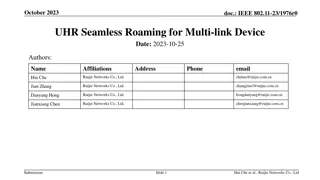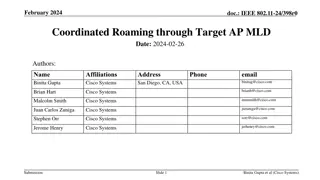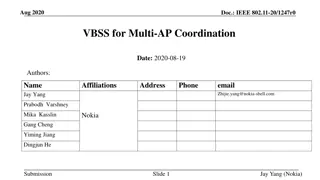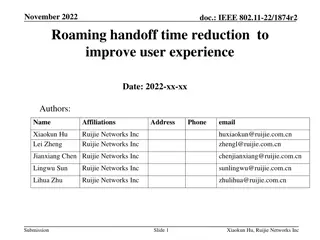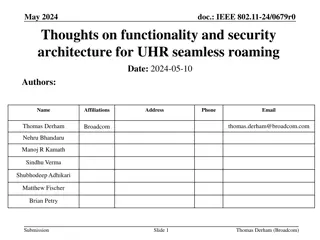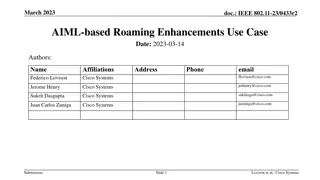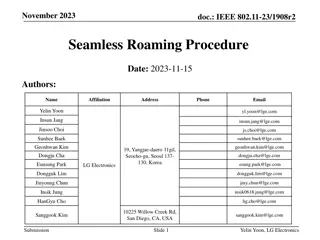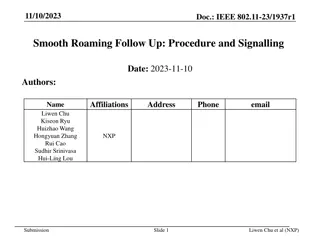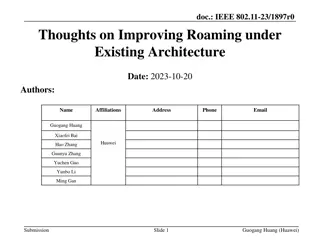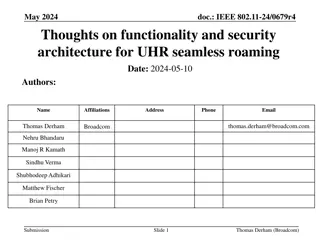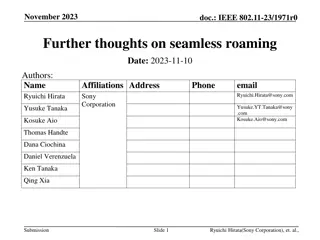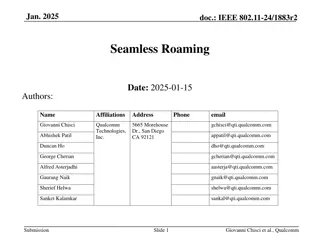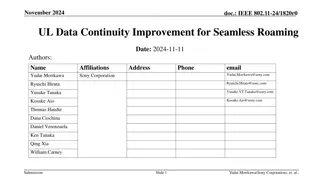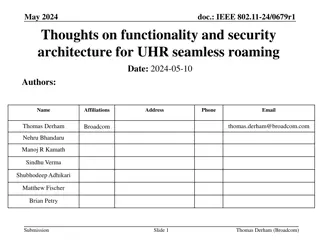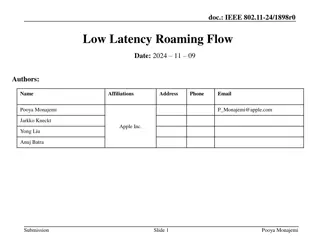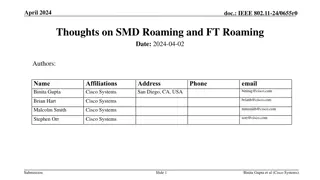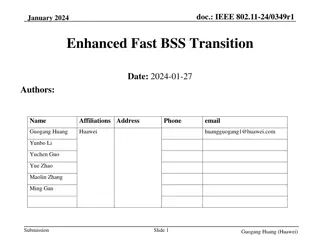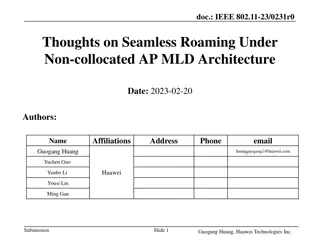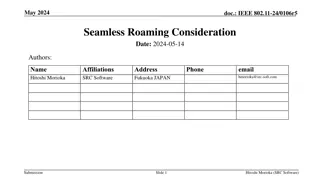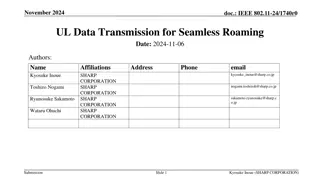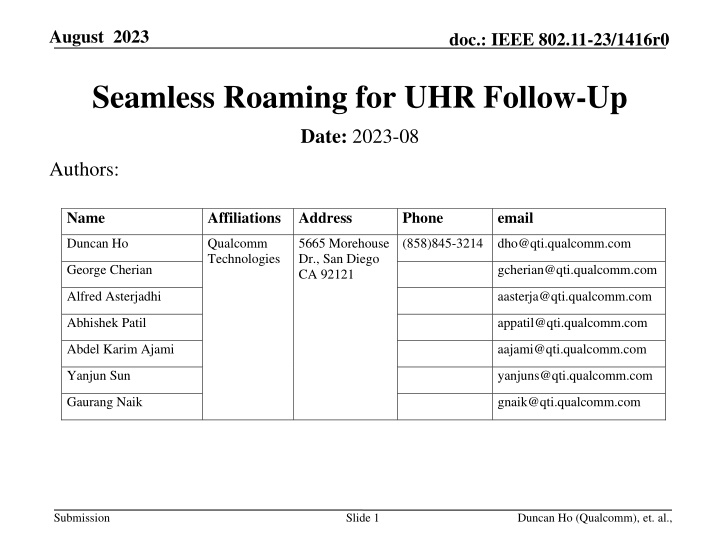
IEEE 802.11-23/1416r0 Seamless Roaming for UHR Overview
Explore the latest developments in achieving seamless roaming for UHR networks as discussed in the IEEE 802.11-23/1416r0 document. Key points include discussions on general direction, AP MLD vs. SMD, and the 3 phases of seamless roaming.
Download Presentation

Please find below an Image/Link to download the presentation.
The content on the website is provided AS IS for your information and personal use only. It may not be sold, licensed, or shared on other websites without obtaining consent from the author. If you encounter any issues during the download, it is possible that the publisher has removed the file from their server.
You are allowed to download the files provided on this website for personal or commercial use, subject to the condition that they are used lawfully. All files are the property of their respective owners.
The content on the website is provided AS IS for your information and personal use only. It may not be sold, licensed, or shared on other websites without obtaining consent from the author.
E N D
Presentation Transcript
August 2023 doc.: IEEE 802.11-23/1416r0 Seamless Roaming for UHR Follow-Up Date: 2023-08 Authors: Name Affiliations Address Phone email Duncan Ho Qualcomm Technologies 5665 Morehouse Dr., San Diego CA 92121 (858)845-3214 dho@qti.qualcomm.com George Cherian gcherian@qti.qualcomm.com Alfred Asterjadhi aasterja@qti.qualcomm.com Abhishek Patil appatil@qti.qualcomm.com Abdel Karim Ajami aajami@qti.qualcomm.com Yanjun Sun yanjuns@qti.qualcomm.com Gaurang Naik gnaik@qti.qualcomm.com Submission Slide 1 Duncan Ho (Qualcomm), et. al.,
August 2023 doc.: IEEE 802.11-23/1416r0 Summary of this Presentation Collected more feedback from offline discussions This version clarifies the following aspects: General direction AP MLD vs Single Mobility Domain (SMD) AP MLD More details on 3 Phases of seamless roaming Context transfer and standardization Targeting scenarios Submission Slide 2 Duncan Ho (Qualcomm), et. al.,
August 2023 doc.: IEEE 802.11-23/1416r0 General Direction It seems that most are interested in achieving the following to enhance roaming in UHR Avoid re-authentication, reassociation and re-establishment of security keys, PN, SN, BA sessions, etc. to keep the roaming delay and interruption minimum Leaving the AP MLD untouched so it continues to serve pre-UHR STAs (or UHR STAs that do not support seamless roaming) Some context transfer is needed during transition Either the client or the network can initiate seamless roaming Prefer not to have two non-colocated APs serving the non-AP MLD concurrently for an unbounded time Submission Slide 3 Duncan Ho (Qualcomm), et. al.,
August 2023 doc.: IEEE 802.11-23/1416r0 AP MLD vs SMD AP MLD Need to keep the AP MLD, which is still needed to serve pre-11bn clients Create an MLD-like entity (SMD AP MLD) that manages all the APs (colocated or not) and maintains the following context with an 11bn client: Authen/assoc/security/PN/SN/BA sessions, etc The entity can be physically located anywhere, including in one of the APs An 11bn non-AP MLD that supports this feature associates with this entity directly (and not to the AP MLDs) Submission Slide 4 Duncan Ho (Qualcomm), et. al.,
August 2023 doc.: IEEE 802.11-23/1416r0 3 Phases of Seamless Roaming Phase 1 - Preparation New target AP(s) will be discovered and added by the non-AP MLD or SMD AP MLD Detection of roaming condition: either by the client or the network Phase 2 - Transition Initiation of roaming: either by the client or the network Serving AP transfers the context (and optionally forward DL packets depending on the capability of the backhaul) to the target AP Serving AP attempts to complete the buffered DL packets (and any DL in-flight packets from the Gateway to the serving AP). STA attempts to finish the UL packets with the serving AP Data path switched to the target AP Depending on the network configuration, there may be a short overlap in time where the STA is served by both the serving AP and the target AP e.g., a single radio STA could be served by both APs that are operating on the same primary channel STA starts to use the target AP for both UL and DL traffic Phase 3 Post-Transition STA will only communicate with the target AP and the spec can define a time-out after which the old AP is removed, along with any context of the non-AP MLD kept at the old AP Submission Slide 5 Duncan Ho (Qualcomm), et. al.,
August 2023 Context Transfer & Standardization doc.: IEEE 802.11-23/1416r0 During Phase 2 (transition), context needs to be transferred from the serving AP to the target AP Context may include: security, PN, SN, BA sessions, QoS, etc 802.11 spec will focus on the requirements needed for the air interface protocol to support seamless roaming: May specify the type of information (at a high level) to be exchanged between the APs to cover the most common use cases Since there are many different backhaul architectures, it may be difficult to capture all the cases. Should keep it at high level so not to preclude/contradict any existing backhaul architectures Submission Slide 6 Duncan Ho (Qualcomm), et. al.,
August 2023 doc.: IEEE 802.11-23/1416r0 Target Scenario Some offline feedback indicated allowing both serving and target APs to serve the STA concurrently even after roaming could create complexity => Agreed that 11bn not to allow concurrent transmissions (from multiple non-colocated APs to the STA) outside of the transition phase (Phase 2 in this slide) Submission Slide 7 Duncan Ho (Qualcomm), et. al.,
August 2023 doc.: IEEE 802.11-23/1416r0 Conclusion We see there are lots of commonalities between several proposals from different members and most are trying to achieve the following goals: Either the APs or the STA can initiate seamless roaming Keep using the same encryption key No reauthen, reassoc, and no need to re-establish the BA sessions Should be able to operate without resetting the PN and SN 1bn should limit concurrent serving by non-colocated APs to only during the roaming phase Submission Slide 8 Duncan Ho (Qualcomm), et. al.,
August 2023 doc.: IEEE 802.11-23/1416r0 APPENDIX Recap of the seamless roaming proposal Submission Slide 9 Duncan Ho, Qualcomm Incorporated
August 2023 doc.: IEEE 802.11-23/1416r0 Seamless Roaming An SMD AP MLD controlling all the APs (colocated or not) SMD AP MLD (logical entity, physically could be co-located with any of the AP below for each client) Data path Router Affiliated APs (non-colocated) AP3 APn AP1 AP2 STAx STAy Note: SN/PN assignment, encryption are still performed at each AP inline with the existing MLO architecture Submission Slide 10 Duncan Ho, Qualcomm Incorporated

